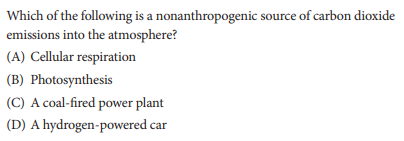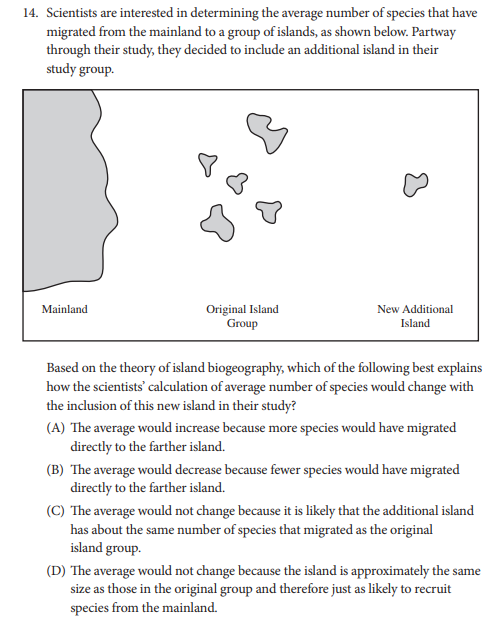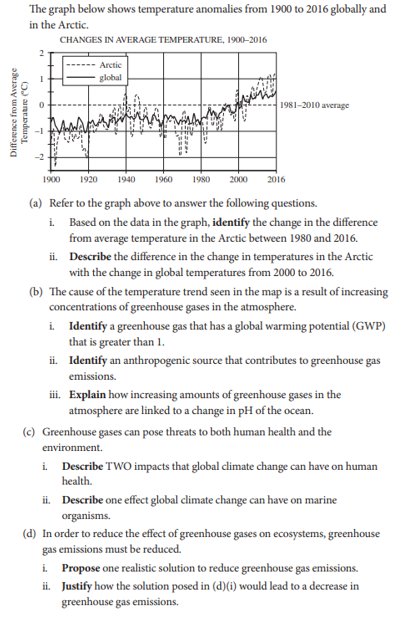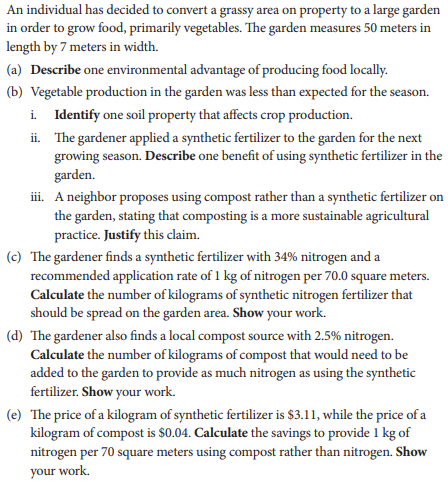Ultimate Guide to the AP Environmental Science Exam
The AP Environmental Science exam is one of the APs most commonly taken as a self-study test. Though many students do enroll in the actual class, this particular exam is also well-suited to self-studying due to its heavy emphasis on vocabulary and highly-specific theory. If you are planning to take the AP Environmental Science exam, whether you have taken the class or self-studied, look no further. Here are CollegeVine’s best tips for the AP Environmental Science exam! The College Board will administer the 2020 AP Environmental Science exam on Monday, May 11, at 12 pm. For a complete list of all the AP exams, along with tips for success and information about how students score, check out our article 2020 AP Exam Schedule: Everything You Need to Know. Environmental science is the study of the scientific principles, content, and methodologies necessary for understanding the natural world. In the AP Environmental Science course, students learn to identify and analyze environmental problems. Students also gain knowledge about earth systems and resources, the living world, land and water use, energy resources and consumption, pollution, and global change. The AP Environmental Science course contains two essential learning components: science practices and big ideas. Science Practices: There are seven science practices that you’ll use when exploring concepts throughout the course. These practices form the basis of the tasks you’re asked to perform on the AP Environmental Science exam. The seven science practices are: Big Ideas: Big ideas are the overarching concepts or themes that run throughout the course. You’ll use the AP Environmental Science exam’s big ideas to make connections between concepts and develop a deeper understanding of them. The four big ideas of the AP Environmental Science Exam are: 2. Interactions Between Earth Systems: How earth is an interconnected system, natural systems change over time, and biogeochemical systems vary in ability to recover from disturbances. 3. Interactions Between Different Species and the Environment: The altering of natural systems by humans, how technology and population growth increase humans’ impact on the environment. 4. Sustainability: Developing sustainable systems for human survival and understanding the role culture, society, and economics play in the development of solutions. AP Environmental Science Course Content There are prerequisites for the AP Environmental Science course. To successfully understand the material found in the AP Environmental Science course, students should have completed two years of high school laboratory science—one year of life science (biology) and one year of physical science (chemistry). Because of the quantitative analysis done in the course, students also need to have taken an Algebra class. Lastly, though not required, it’s advantageous for students to have completed a class in earth science. The AP Environmental Science course is commonly broken down into nine units. Below is a suggested sequence of the course units from the College Board, along with the weight they’re given on the multiple-choice section of the AP Environmental Science exam. The AP Environmental Science exam takes place over the course of 2 hours and 40 minutes and consists of two sections: multiple choice and free response. Section 1: Multiple Choice 1 hour 30 minutes | 80 questions | 60% of score The first section contains 80 multiple-choice questions which make up 60% of your total score. There are 90 minutes allowed for this section. The format of this section has been modified for 2020; most notably, there are 20 fewer questions than the previous exam and the number of possible answers has shrunk from 5 to 4. Furthermore, questions now equally emphasize the analysis of quantitative data, along with data in the form of models and representations. The multiple-choice section of the AP Environmental Science exam includes both individual questions and sets of questions based on the same stimulus. Students will encounter 3-4 sets of questions using quantitative data (data tables, charts, and graphs) and 3-4 sets of questions based on qualitative data or information (models, representation, and maps). New to the AP Environmental Science exam this year are two sets of questions based on text sources. Example of a multiple-choice question: Example of a multiple-choice question using quantitative data as the stimulus: Example of a multiple-choice question using qualitative data as the stimulus: Section 2: Free Response 1 hour 10 minutes | 3 questions | 40% of score The second section of the AP Environmental exam has also seen changes for 2020. It now consists of 3 free response questions instead of 4, and the types of questions asked have changed as well. The three new questions are as follows: Question 1 – Design an Investigation: You’re given a real-world scenario along with qualitative and quantitative data. Using the provided material, you may need to describe the environmental problems or potential responses. Question 2 – Analyze an Environmental Problem and Propose a Solution: You’re given an authentic environmental scenario and either a model/visual representation or quantitative data. Using the given information, you’ll need to propose and justify solutions to the posed environmental problems. Question 3 – Question 3: Analyze an Environmental Problem and Propose a Solution Doing Calculations: You’re tasked with proposing and justifying solutions to a genuine environmental problem using a calculation to support your solution. It’s worth noting that you may use a four-function (with square root), scientific, or graphing calculator on the exam. For further questions about AP-approved calculators, consult the College Board’s Calculator Policy. Because the AP Environmental Science exam was reformatted for 2020, there is limited availability of sample free response questions. Below is an example of an “Analyze an Environmental Problem and Propose a Solution” question and an “Analyze an Environmental Problem and Propose a Solution Doing Calculations” question. In 2019, 49.2% of students who took the AP Environmental Science exam received a “passing” score of 3 or better. Only 9.4% of test-takers achieved a top score of 5, while 25.4% of test-takers scored a 1. These scores are likely somewhat skewed by the popularity of this test with self-study test-takers. Students who prepare seriously will often find that the test is not as difficult as the results indicate. If you’re curious about other score distributions, see our post Easiest and Hardest AP Exams. A full course description that can help guide your studying and understanding of the knowledge required for the test can be found on the College Board course description. For tips on preparing for the exam, read on! First, take a practice test or do some sample questions. It’s important to start your studying off with a good understanding of your existing knowledge. Although the College Board AP Environmental Science website provides a number of sample test questions, it does not provide a complete sample test. You can find a practice test in many of the official study guides, and some even include a diagnostic test to act as your initial assessment. The College Board has released one old AP Environmental Science exam that you can use for practice; however, the test is from 1998 and will differ from the exam in its current form. The College Board also has made the AP Environmental Science exam from 2008 available for purchase on their website. Once again, be aware that this test is not structured as the test is now. Flashcards: The bulk of the material you will need to learn for the AP Environmental Science exam consists of highly specific vocabulary and knowledge of scientific principles and processes. These types of topics lend themselves well to rote memorization. Things like repetitive flashcard use and quizzing yourself will help to cement these in your mind. If you’re not sure where to start, think back to how you learned your spelling words best in grade school and use similar techniques. This could include having a friend or parent quiz you, using flashcards on Quizlet, or coming up with pneumonic devices or acronyms. Ask the Experts: There are some strong study guides available for purchase also. The Barron’s AP Environmental Science, 8th Edition is a good resource that has been updated for the latest version of the exam, but is sometimes criticized for providing too much information with less summarization. It can be used more like a textbook overview. Ask a Teacher: There are also many free study resources available online. Some AP Environmental Science teachers have posted free study guides, review packets, and readings. You can find one such as this AP Environmental Science study guide and this series of AP Environmental Science videos by bozemanscience. Just keep in mind that many online resources will be from previous versions of the test, so be sure to only study what is relevant to the updated exam. A New Way to Study: Another new and convenient way to study is to use a study app for AP exams, such as this AP Environmental Science app from Varsity Tutors. These apps are especially useful for quizzing yourself on-the-go. Make sure you read reviews before choosing one, though—their quality varies widely. Once you have your theory down, test it out by practicing multiple-choice questions. You can find these in most study guides or through online searches. You could also try taking the multiple-choice section of a practice exam. One diagnostic test that is available for free online and includes lots of practice multiple-choice questions can be found here. Study.com and Varsity Tutors also offer free AP Environmental Science Practice exams. Try to keep track of which areas are still tripping you up, and go back over this theory again. Pay close attention to the task verbs used in the free response prompts. On the AP Environmental Science exam, these most commonly include: describe, identify, give one reason why, discuss, explain, give a specific example, and calculate. Know precisely what each one of these words is asking you to do. Underline each section of the question, circle the task verb, and check them off as you write. Many students lose points by simply forgetting to include one part of a multipart question. When writing your response, try to use the same task verb in your answer. For example, if you were asked to “Give a specific example,” start that part of your answer with: “One specific example of this would be…” Finally, make sure to review the examples of scored free response questions so that you can understand exactly what to expect in this section and how you will be evaluated. The College Board provides examples of actual prompts dating back to 1999. These examples include authentic student responses and commentary and are great for gaining a deeper understanding of the types of answers the College Board is looking for. Once again, keep in mind the free response questions have changed for 2020. As you did at the very beginning of your studying, take a practice test to evaluate your progress. You should see a steady progression of knowledge, and it’s likely that you will see patterns identifying which areas have improved the most and which areas still need improvement. If you have time, repeat each of the steps above to incrementally increase your score. If you’re taking the AP course associated with this exam, your teacher will walk you through how to register. If you’re self-studying, check out our blog post How to Self-Register for AP Exams. For information about what to bring to the exam, see our post What Should I Bring to My AP Exam (And What Should I Definitely Leave at Home)? If you can make sense of sustainable development, but the college admissions process has you scratching your head, don’t worry—CollegeVine has you covered. Our free chancing engine uses data such as GPA, test scores, and extracurricular activities to give you your odds of acceptance at over 500 colleges. Sign up for your free CollegeVine account to start using our chancing engine today! For more information on AP exams, check out these other excellent articles: When is the AP Environmental Science Exam?
About the AP Environmental Science Exam
Skill
Description
Percentage of Exam Score (Multiple-Choice Section)
Percentage of Exam Score (Free Response Questions)
Concept Explanation
Explain environmental concepts, processes, and models presented in text.
30%–38%
13%–20%
Visual Representations
Analyze visual representations of environmental concepts and processes.
12%–19%
6%–10%
Text Analysis
Analyze sourced information about environmental issues.
6%–8%
Not assessed in the free response section.
Scientific Experiments
Analyze research studies that test environmental principles.
2%–4%
10%–14%
Data Analysis
Analyze and interpret quantitative data represented in tables, charts, and graphs.
12%–19%
6%–10%
Mathematical Routines
Apply quantitative methods to environmental concepts.
6%–9%
20%
Environmental Solutions
Propose and justify solutions to environmental problems.
17%–23%
26%–34%
Unit
Percentage of Exam Score (Multiple-Choice Section)
The Living World: Ecosystems
6%-8%
The Living World: Biodiversity
6%-8%
Populations
10%-15%
Earth Systems and Resources
10%-15%
Land and Water Use
10%-15%
Energy Resources and Consumption
10%-15%
Atmospheric Pollution
7%–10%
Aquatic and Terrestrial Pollution
7%–10%
Global Change
15%–20%
AP Environmental Science Exam Content





AP Environmental Science Score Distribution, Average Score, and Passing Rate
Exam
5
4
3
2
1
AP Environmental Science
9.4%
25.7%
14.1%
25.4%
25.4%
Best Ways to Study for the AP Environmental Science Exam
Step 1: Assess Your Skills
Step 2: Study the Material
Step 3: Practice Multiple-Choice Questions
Step 4: Practice Free Response Questions
Step 5: Take Another Practice Test
Step 6: Exam Day Specifics





